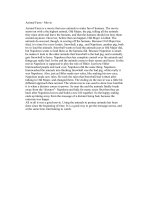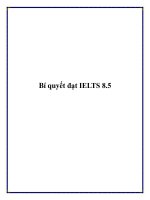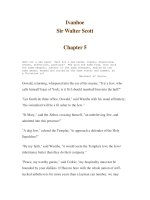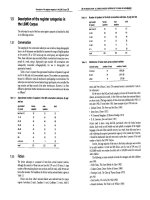outlinging essay 5 pot
Bạn đang xem bản rút gọn của tài liệu. Xem và tải ngay bản đầy đủ của tài liệu tại đây (71.1 KB, 6 trang )
Section 1: Reading Comprehension
Answer questions 1–8 on the basis of the following
passage.
(1) Produced in 1959, Lorraine Hansberry’s play, A
Raisin in the Sun, was a quietly revolutionary work
that depicted African-American life in a fresh, new,
and realistic way. The play made her the youngest
American, the first African-American, and the fifth
woman to win the New York Drama Critic’s Circle
Award for Best Play of the Year. In 1961, it was pro-
duced as a film starring Sydney Poitier and has since
become a classic, providing inspiration for an
entire generation of African-American writers.
(2) Hansberry was not only an artist but also a
political activist and the daughter of activists. Born
in Chicago in 1930, she was a member of a promi-
nent family devoted to civil rights. Her father was a
successful real-estate broker, who won an anti-seg-
regation case before the Illinois Supreme Court in
the mid-1930s, and her uncle was a Harvard pro-
fessor. In her home, Hansberry was privileged to
meet many influential cultural and intellectual lead-
ers. Among them were artists and activists such as
Paul Robeson, W.E.B. DuBois, and Langston
Hughes.
(3) The success of A Raisin in the Sun helped gain
an audience for her passionate views on social jus-
tice. It mirrors one of Hansberry’s central artistic
efforts, that of freeing many people from the
smothering effects of stereotyping by depicting the
w
ide array of personality types and aspirations that
exist within one Southside Chicago family. A Raisin
in the Sun was followed by another play, produced
in 1964, The Sign in Sidney Brustein’s Window. This
play is about an intellectual in Greenwich Village,
New York City, a man who is open-minded and
generous of spirit who, as Hansberry wrote, “cares
about it all. It takes too much energy not to care.”
(4) Lorraine Hansberry died on the final day of
the play’s run on Broadway. Her early death, at the
age of 34, was unfortunate, as it cut short a brilliant
and promising career, one that, even in its short
span, changed the face of American theater. After
her death, however, her influence continued to be
felt. A dramatic adaptation of her autobiography, To
Be Young, Gifted, and Black, consisted of vignettes
based on Hansberry’s plays, poems, and other writ-
ings. It was produced Off-Broadway in 1969 and
appeared in book form the following year. Her play,
Les Blancs, a drama set in Africa, was produced in
1970; and A Raisin in the Sun was adapted as a
musical, Raisin, and won a Tony award in 1973.
(5) Even after her death, her dramatic works have
helped gain an audience for her essays and speeches
on wide-ranging topics, from world peace to the
evils of the mistreatment of minorities, no matter
what their race, and especially for her works on the
civil-rights struggle and on the effort by Africans to
be free of colonial rule. She was a woman, much like
the characters in her best-known play, who was
determined to be free of racial, cultural, or gender-
based constraints.
1. The writer of the passage suggests that Hans-
berry’s political beliefs had their origins in her
experience as
a. the daughter of politically active parents.
b. a successful playwright in New York.
c. a resident of Southside Chicago.
d. an intellectual in Greenwich Village.
e. a civil rights activist.
–CBEST PRACTICE EXAM 1–
159
2. The main purpose of the passage is to
a. praise Lorraine Hansberry’s writings and
illustrate their artistic and political influence.
b. summarize Lorraine Hansberry’s best-known
works.
c. demonstrate that if one is raised in a well-
educated family, such as Lorraine Hansberry’s,
one is likely to succeed.
d. show Lorraine Hansberry’s difficult struggle
and ultimate success as a young female writer.
e. persuade students to read A Raisin In The Sun.
3. Hansberry’s father earned his living as
a. a civil-rights worker.
b. a banker.
c. a real-estate broker.
d. an artist and activist.
e. an attorney.
4. Paragraph 3 suggests that Hansberry’s main pur-
pose in writing A Raisin in the Sun was to
a. win her father’s approval.
b. break down stereotypes.
c. show people how interesting her own family
was.
d. earn the right to produce her own plays.
e. win a Best Play award.
5. By including paragraphs 4 and 5, the author
most likely intended to show that
a. the civil-rights struggle continued even after
Hansberry died.
b. Hansberry actually wrote more poems and
essays than she did plays.
c. Raisin in the Sun was more successful after
Hansberry’s death than it was before she died.
d. Hansberry’s work continued to influence peo-
ple even after her death.
e. Hansberry died unusually young.
6. According to the passage, how many women had
won the New York Drama Critic’s Circle Award
for Best Play of the Year before Lorraine Hans-
berry did?
a. none
b. one
c. four
d. five
e. six
7. As it is used in paragraph 3, the underlined
phrase wide array most nearly means
a. variety.
b. gathering.
c. arrangement.
d. decoration.
e. features.
8. According to the passage, which of the following
dramatic works was based most directly on
Hansberry’s life?
a. A Raisin in the Sun
b. Les Blancs
c. The Sign in Sidney Brustein’s Window
d.
To Be Young, Gifted, and Black
e. the musical Raisin
Answer question 9 on the basis of the following
passage.
Moscow has a history of chaotic periods of war
that ended with the destruction of a once largely
wooden city and the building of a “new” city on top of
the rubble of the old. The result is a layered city, with
each tier holding information about a part of Russia’s
past. In some areas of the city, archaeologists have
reached the layer from 1147, the year of Moscow’s
founding. Among the findings from the various peri-
ods of Moscow’s history are carved bones, metal tools,
pottery, glass, jewelry, and crosses.
–CBEST PRACTICE EXAM 1–
160
9. From the passage, the reader can infer that
a. the people of Moscow are more interested in
modernization than in preservation.
b. the Soviet government destroyed many of the
historic buildings in Russia.
c. Moscow is the oldest large city in Russia,
founded in 1147.
d. Moscow has a history of invasions, with each
new conqueror razing past structures.
e. Moscow has endured many periods of upris-
ing and revolution.
Answer questions 10–13 on the basis of the follow-
ing passage.
Heat reactions usually occur when large amounts
of water and/or salt are lost through excessive sweating
following strenuous exercise. When the body becomes
overheated and cannot eliminate this excess heat, heat
exhaustion and heat stroke are possible.
Heat exhaustion is generally characterized by
clammy skin, fatigue, nausea, dizziness, profuse per-
spiration, and sometimes fainting, resulting from an
inadequate intake of water and the loss of fluids. First
aid treatment for this condition includes having the
victim lie down, raising the feet 8–12 inches, applying
cool, wet cloths to the skin, and giving the victim sips
of salt water (1 teaspoon per glass, half a glass every 15
minutes), over the period of an hour.
Heat stroke is much more serious; it is an imme-
diately life-threatening situation. The characteristics of
heat stroke are a high body temperature (which may
reach 106°F or more); a rapid pulse; hot, dry skin; and
a blocked sweating mechanism. Victims of this condi-
tion may be unconscious, and first aid measures
should be directed at cooling the body quickly. The
victim should be placed in a tub of cold water or
repeatedly sponged with cool water until his or her
temperature is lowered sufficiently. Fans or air condi-
tioners will also help with the cooling process. Care
should be taken, however, not to overchill the victim
once the temperature is below 102°F.
10. The most immediate concern of a person tend-
ing a victim of heat stroke should be to
a. get salt into the victim’s body.
b. raise the victim’s feet.
c. lower the victim’s pulse rate.
d. have the victim lie down.
e. lower the victim’s temperature.
11. Which of the following is a symptom of heat
exhaustion?
a. unconsciousness
b. excessive sweating
c. hot, dry skin
d. a weak pulse
e. a rapid pulse
12. Heat stroke is more serious than heat exhaustion
because heat stroke victims
a. have too little salt in their bodies.
b. cannot take in water.
c. do not sweat.
d. have frequent fainting spells.
e. may have convulsions.
13. On the basis of the information in the passage,
symptoms such as nausea and dizziness in a heat
exhaustion victim indicate that the person most
likely needs to
a. be immediately taken to a hospital.
b. be immersed in a tub of water.
c. be given more salt water.
d. sweat more.
e. go to an air-conditioned place.
Answer questions 14 and 15 on the basis of the fol-
lowing passage.
Poet William Blake believed that true religion is
revealed through art, not through nature. For Blake, it
–CBEST PRACTICE EXAM 1–
161
is through art also that eternity is revealed. One does
not have to die to reach eternity; eternity is the
moment of vision. It is only through the reordering of
sense impressions by the creative imagination that we
are able, as Blake says in his “Auguries of Innocence,”
“To see the World in a Grain of Sand / . . .And Eternity
in an hour.”
14. Which of the following would best describe what
Blake meant by the words “To see the World in a
Grain of Sand / . . . And Eternity in an hour?”
a. a moment of mystical enlightenment
b. conversion to Christianity
c. a moment of artistic inspiration
d. an hallucinatory experience
e. a return to a state of being without sin
15. Which of the following defines Blake’s view of
“nature” as described in the passage?
a. the raw stuff of which the world is made but
which does not represent ultimate reality
b. the work of God in a state of innocence before
it is corrupted by human beings
c. the world made up of base and corrupt mate-
rial before it is changed by the perception of
the artist at the “moment of vision”
d. the temporal world that will perish, as
opposed to the world of artistic vision that
will last forever
e. the real world as it is perceived by ordinary
people, as opposed to the fantasy world of the
artist
Answer questions 16–18 on the basis of the follow-
ing passage.
Businesses today routinely keep track of large
amounts of both financial and non-financial informa-
tion. Sales departments keep track of current and
potential customers; marketing departments keep
track of product details and regional demographics;
accounting departments keep track of financial data
and issue reports. To be useful, all this data must be
organized into a meaningful and useful system. Such a
system is called a management information system,
abbreviated MIS. The financial hub of the MIS is
accounting.
Accounting is the information system that
records, analyzes, and reports economic transactions,
enabling decision-makers to make informed choices
when allocating scarce economic resources. It is a tool
that enables the user, whether a business entity or an
individual, to make wiser, more informed economic
choices. It is an aid to planning, controlling, and eval-
uating a broad range of activities. A financial account-
ing system is intended for use by both the management
of an organization and those outside the organization.
Because it is important that financial accounting
reports be interpreted correctly, financial accounting is
subject to a set of ___________ guidelines called “gen-
erally accepted accounting principles” (GAAP).
16. This passage is most likely taken from
a. a newspaper column.
b. an essay about modern business.
c. a legal brief.
d. a business textbook.
e. a business machine catalog.
17. The word that would fit most correctly into the
blank in the final sentence is
a. discretionary.
b. convenient.
c. instruction.
d. austere.
e. stringent.
–CBEST PRACTICE EXAM 1–
162
18. According to the information in the passage,
which of the following is LEAST likely to be a
function of accounting?
a. helping business people make sound judg-
ments
b. producing reports of many different kinds of
transactions
c. assisting with the marketing of products
d. assisting companies in important planning
activities
e. providing information to potential investors
Answer questions 19 and 20 on the basis of the fol-
lowing passage.
The fictional world of Toni Morrison’s novel
Sula—the African-American section of Medallion,
Ohio, a community called “the Bottom”—is a place
where people, and even natural things, are apt to go
awry, to break from their prescribed boundaries, a
place where bizarre and unnatural happenings and
strange reversals of the ordinary are commonplace.
The very naming of the setting of Sula is a turning-
upside-down of the expected; the Bottom is located
high up in the hills. The novel is furthermore filled
with images of mutilation, both psychological and
physical. A great part of the lives of the characters,
therefore, is taken up with making sense of the world,
setting boundaries and devising methods to control
what is essentially uncontrollable. One of the major
devices used by the people of the Bottom is the seem-
ingly universal one of creating a ____________—in
this case, the title character Sula—upon which to proj-
ect both the evil they perceive outside themselves and
the evil in their own hearts.
19. Based on the description of the setting of the
novel Sula, which of the following adjectives
would most likely describe the behavior of many
of its residents?
a. cowardly
b. artistic
c. unkempt
d. arrogant
e. eccentric
20. Which of the following words would BEST fit
into the blank in the final sentence of the
passage?
a. victim
b. hero
c. leader
d. scapegoat
e. outcast
Answer questions 21–23 on the basis of the follow-
ing passage.
Ever since human beings began their conscious
sojourn on this planet, they have puzzled over the rid-
dle of evil and debated its source. Two concepts have
predominated in the debate. The first of these holds
that evil is an active force, a force of darkness as sub-
stantial and powerful as that of light. In terms of the
individual human being, this force might be seen as
the “Shadow” side of the personality, the feared side
that the individual may deny but that is still a real and
integral part of her or him. The second of the two con-
cepts holds that evil is essentially ___________, the
absence of good, that darkness is not a thing in itself
but rather the absence of light. In terms of the indi-
vidual human being, this doctrine says that evil arises
from a lack, a deprivation, from what John A. Sanford
calls “a mutilation of the soul.”
–CBEST PRACTICE EXAM 1–
163









